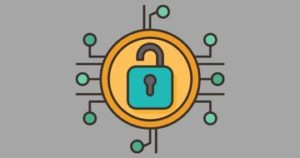Introduction
The world of Cybersecurity is generally made of attackers and defenders. The world of attackers is known as the “cyber threat landscape” and it’s filled with many different types of threats.
Knowing the most common types of cyber attacks is important to effectively protect your business because each type of attack requires different defensive measures.
Protecting your whole attack surface is critical because even a single breach can cause disastrous effects for a business.
In fact, reports show that approximately two-thirds of small and medium-sized businesses (SMBs) shut down within six months of experiencing a successful cyber attack.
The best way to outsmart the hackers seeking to cause damage is by learning about the malicious attack methods they use. Then, you’ll be able to better protect yourself and your business and avoid becoming the next victim.
Most Common Types of Cyber-Attacks

So let’s dive into the world of hacking.
Just remember, knowledge is power… and a great way to protect yourself from being hacked.
So, you might want to make sure that your coworkers and friends are also aware.
Now let’s get nerdy and review the most common cyber-attacks and understand how they can negatively impact business operations.
Trojanized Software Applications
What Are Trojanized Software Applications?
Trojanized applications, or trojanized apps, are legitimate software programs that hackers have modified to include malicious code. This code is often designed to steal sensitive data or give the attacker remote access to your device.
Trojanized apps are distributed through various means, such as malicious and legitimate websites, social media, phishing email attachments, or even by being bundled with other legitimate software. But, these types of attacks essentially rely on one thing: enticing the victim into installing them.
To accomplish this part of the attack, hackers choose to trojanize apps that users will certainly want to install. Sometimes this could be a popular game or a costly software application.
By claiming to offer a “free” version, attackers can easily get victims to fall for their evil plans. But, in the end, the cost is not really free when you consider the costs of a cyberattack, right?
Other times, the trojanized app might not be well known, but rather pretends to be a new viral app that everyone is in love with, or an app with big benefits for hard-working professionals to make their job easier.
Either way, it’s important to recognize that every piece of software you install on your device is a potential vector to let a hacker in. So be cautious when downloading and installing software. Only get apps from trusted sources and use security software such as a malware scanner to protect against trojanized apps.
How Do Trojanized Software Applications Impact Business?
A trojanized application can have a seriously destructive impact on a business. These types of attacks can result in the theft of sensitive company data, such as intellectual property, financial information, or personal details of employees and customers. This can lead to financial loss and damage to a company’s reputation.
Trojanized apps also offer the hacker access to devices inside the company’s network and a doorway to the rest of the corporate network. This could allow them to steal more sensitive data, disrupt business operations, and install additional “second-stage” malware such as ransomware.
This whole process results in costly downtime and other potentially permanent disruptions to the business. Therefore, it is important to be vigilant about protecting against trojanized apps.
Phishing Attacks

What Are Phishing Attacks?
Phishing attacks are a type of cyber attack that uses fake emails or websites to trick individuals into revealing their usernames and passwords or opening a document that contains malware.
Phishing emails and sites use social engineering tactics to create a sense of urgency and manipulate the victim. They are designed to create emotions such as happiness when you win a prize or worry that your package delivery will be delayed.
Either way, if you are tricked into taking action, you are potentially giving the hacker a doorway into your computer system.
Spear-phishing attacks are a highly targeted form of phishing where the attacker uses specific information to make the attack more effective.
For example, the message might include the victim’s name, and job title, or seem to come from a close family member, friend, or even their boss. These personal details make the attack seem more legitimate.
Spear-phishing attacks can be particularly effective because they seem to come from a familiar source and are thus more difficult for people to detect.
How Do Phishing Attacks Impact Business?
Phishing attacks are considered “first-stage” attacks and they are the most common way that attackers gain initial access to a victim’s network.
Because an attacker can put malware in an attachment such as a Microsoft Word document or on a malicious website, it only takes one click to give the hacker access to your device. If successful, the attacker can quickly infect your device and start to execute “second stage” attacks.
If the infected device contains stored passwords or sensitive files, is connected to a corporate network, or has access to cloud apps such as email or file-sharing apps, the attacker can do serious damage.
Therefore, it is important to be cautious and verify the authenticity of any communication before opening attached files or clicking a link. Using security software and regularly updating software and devices can also help protect against these types of attacks.
Ransomware Attacks
What Are Ransomware Attacks?
Ransomware is a type of malware designed to encrypt a victim’s files. Once the files are encrypted, the victim cannot access them. This allows the attacker to demand money – often in the form of cryptocurrency – in return for a decryption key that can restore access to the damaged files.
Sometimes the ransom demands reach millions of dollars. The only real protection from a ransomware attack is having recent backups that are stored offline to recover your files.
To make matters worse, some ransomware gangs even try double or triple extortion methods to get even more money out of their victims.
In a double extortion ransomware attack, the attacker not only encrypts the victim’s files but also steals a copy for themself and threatens to release them to the public if the victim doesn’t pay. A triple extortion ransomware attack involves threats of launching DOS attacks against the victim.
Wow, that is a true triple threat!
How Do Ransomware Attacks Impact Business?
Ransomware can cause real and serious financial hardship to a business. The average ransom demand in 2022 was almost $1 million USD.
Another way that a ransomware attack can hurt a business is when a company loses access to critical data.
In some cases, this is enough for companies to pay the ransom, which isn’t much better since in itself is a big financial loss.
To make matters worse, when the attacker turns over the decryption keys, most companies have to pay even more money for help recovering from the attack. This is because most companies don’t have this kind of disaster recovery IT experts on hand.
Finally, ransomware can cause reputational damage to a company. If customers lose their data it can be a big inconvenience, and if their data has been stolen by criminals, it can lead to identity theft and spear-phishing attacks against them.
All this adds up to ransomware being the biggest overall threat to businesses in the modern digital era.
Malicious Software Packages
What Are Malicious Software Packages?
Open-source software packages or libraries benefit software developers because they allow them to develop software or websites much more quickly. By borrowing someone else’s code developers can add new features more quickly and easily, and with lower overall cost.
For the most part, shared software packages for languages such as PHP, Python, NodeJS, or Ruby are legitimate and safe. However, hackers have also used precompiled packages to spread malware.
How Malicious Software Packages Impact Business?
Malicious third-party software libraries can have a significant impact on business operations in the same way that other forms of malware can. They can potentially allow an attacker to gain remote access to a system, steal sensitive data, and import additional types of malware.
However, when a software developer distributes their product with a vulnerability in it, attackers can hack their customers in what is known as a “supply chain attack”.
In the end, this can cause a company significant loss of business caused by fleeing customers and long-term reputational damage. These attacks can also lead to other types of attacks such as phishing when attackers use stolen data against the companies, or ransomware attacks when attackers import additional malware to extend the attack.
Distributed Denial Of Service (DDOS) Attacks
What Are DDOS Attacks?
Denial Of Service (DOS) attacks involve overwhelming a website or network with traffic, making it difficult or impossible for users to access it. A Distributed Denial Of Service attack (DDOS) refers to a DOS attack that uses a botnet of thousands of hacked devices to overwhelm an online service.
By using so many devices together in a single attack, hackers make it next to impossible for defenders to block all the malicious requests. This is because they all use a different IP address making it impossible to tell the normal users from the attacker’s botnet. This leads to “resource exhaustion” when the poor computer just can’t keep up with all the demands.
How Do DDOS Attacks Impact Business?
By definition, DDOS attacks prevent users from accessing services. For a business, this could mean the systems and data staff need to do their job.
At a minimum, this could damage a company’s reputation by not being able to deliver its products and services and financial loss if customers can’t make purchases. But when DDOS attacks have affected critical services such as a hospital or other critical infrastructure, they have even caused deaths.
To mitigate against these potential losses it is important for businesses to have measures in place to protect against DDOS attacks, such as using a next-generation web application firewall (WAF) and working with a reputable hosting provider that has experience handling DDOS attacks.
Brute Force Attacks

What Are Brute Force Attacks?
Brute-force attacks are a type of cyber attack in which hackers use automated software to guess passwords or other login credentials by trying a large number of combinations. Brute force attacks can take many forms, but the most important types to take note of here are online and offline brute force attacks.
Online brute force attacks are directed at an online resource directly. The could be a website or other type of connection such as a file-sharing (FTP), database, or any other remote connection to a server.
The important thing to remember about an online brute force attack is that the attacker is communicating directly with the victim’s system.
However, in an offline brute force attack, hackers use their own computers to try and crack a stolen password hash or other stolen password-protected file.
The important thing to know about offline brute force attacks is that the victim cannot detect that it is happening because the attacker is only using their own computer to brute force some data that has been stolen.
How Do Brute Force Attacks Impact Business?
Both successful and unsuccessful brute-force attacks can have significant impacts on businesses. If successful, they can allow hackers to gain unauthorized access to a company’s systems, steal sensitive data, or disrupt operations.
For example, if a hacker is able to hack an employee’s account login, they may be able to access other sensitive systems and data on the company’s network. This can lead to data theft, ransomware attacks, or attacks such as DOS attacks, installing additional malware, or making unauthorized changes.
Even unsuccessful online brute-force attacks can impact businesses by consuming resources and slowing down systems. As a hacker repeatedly tries to guess a password, they will consume large amounts of computing power and bandwidth, causing slower systems and disrupting operations.
Cross-Site Scripting Attacks
What Are Cross-Site Scripting Attacks?
Cross-Site Scripting (XSS) attacks are a type of cyber attack in which hackers inject malicious code into a website or web application. While theoretically, XSS can happen with several web-scripting languages, most XSS attacks leverage JavaScript.
When an XSS is executed on a website, it can steal sensitive information from the user’s browser session, such as session cookies, login credentials, or financial information, or install malware on a user’s device.
There are two main types of XSS attacks: reflected and stored.
Reflected XSS attacks embed malicious code into a URL link that is immediately executed in the browser when a user visits the link. Stored XSS attacks involve injecting malicious code into a website’s backend database by putting it into an input form such as a product review comment or social media message.
Then, when a user visits the site and that content is displayed on a page, it executes the hacker’s payload.
Protecting against XSS requires properly filtering and encoding all user-submitted input. That will remove any special characters that are used to invoke JavaScript code that could be executed at an inappropriate time.
For example, because JavaScript-based XSS attacks depend on script tags: “<” and “>”, encoding these characters into HTML entities “<” and “>” is an effective way to prevent basic XSS attacks.
How Do Cross-Site Scripting Attacks Impact Business?
XSS attacks can have serious consequences for businesses, as they can result in the theft of sensitive data which can lead to the abuse of a customer’s account, damage a company’s reputation, and cause financial loss.
Therefore, it is important for businesses to take steps to protect against XSS attacks. Since hackers are always trying new ways to encode their data and escape filters, one way is to regularly update software and devices.
Another way is to implement strict input validation and sanitization, to prevent the injection of malicious code. Using security software such as malware scanners and regularly training employees on how to identify and avoid phishing attacks can also help protect against these types of threats.
Summary
Understanding how cyber attacks occur is essential for businesses to protect themselves and their customers against a cyber breach. The fact is, there is no “silver bullet” that can protect against all kinds of cyber attacks.
Rather, it is critically important for IT defenders to understand how each common attack type works and implement defensive measures to specifically protect against each attack type. By planning a defensive strategy this way, defenders can ensure they cover their attack surface more effectively than using an ad-hoc approach.
Implementing robust cybersecurity measures should always include regularly backing up data, training employees to recognize and report suspected phishing emails, keeping software and systems up to date with the latest security patches, designing applications with security in mind, and staying away from untrusted software applications.
By taking the right precautions for the strategy used by the bad guys, businesses can reduce the chances of a successful cyber attack and protect themselves from the potentially devastating consequences of a cyber breach.









